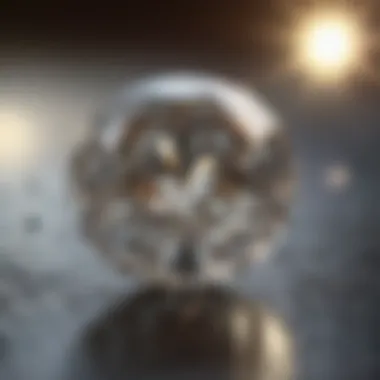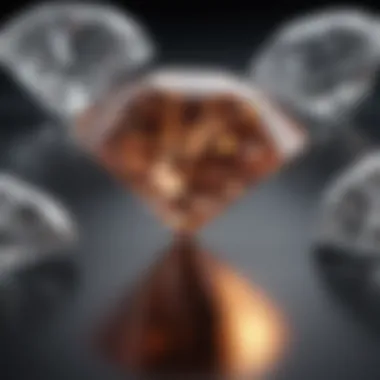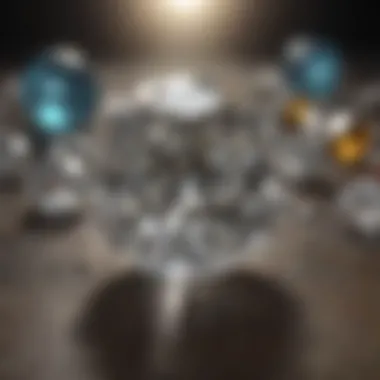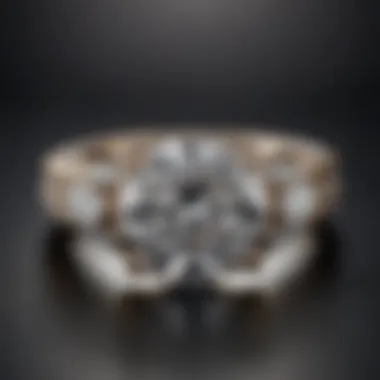Understanding Diamond Clarity: A Comprehensive Guide


Intro
The evaluation of diamonds involves a multitude of factors, among which clarity stands out as a pivotal element. Clarity refers to the presence of inclusions and blemishes, which impact not only the aesthetics of a diamond but also its value. Understanding this aspect is crucial for anyone involved in the gemstone industry, be it collectors, designers, or simply enthusiasts. The upcoming sections will break down the idea of clarity, exploring its various grades, the significance of inclusions and blemishes, and how these factors relate to the market value and overall appeal of diamonds.
Gemstone Overview
Definition and Characteristics
Diamonds are a form of carbon that has undergone extreme conditions resulting in their distinctive crystal structure. This unique formation contributes to their famed hardness and brilliance. A diamond's physical properties include a high refractive index, which gives it a sparkling appearance, and strong dispersion, which produces a colorful play of light when cut properly.
Classification of Gemstones
Gemstones can be classified into two main categories: precious and semi-precious. Diamonds fall under the precious gemstone category, which also includes sapphires, rubies, and emeralds. The classification often depends on the gemstone's rarity, quality, and market demand, but diamonds are universally recognized for their remarkable qualities and significance in various cultures.
Historical Significance
Ancient Uses and Cultural Importance
Diamonds have held a place of reverence across different cultures throughout history. In ancient India, they were associated with strength and protection, often being used in armor. The Greeks believed diamonds were tears of the gods, imbuing them with mystical properties. This historical context emphasizes the enduring allure of diamonds beyond mere aesthetics.
Myths and Legends Surrounding Gemstones
Around the globe, diamonds have been steeped in myths and legends. For example, it was once believed that diamonds could ward off evil spirits, enhancing their value and desirability. These narratives not only add to the charm of diamonds but also solidify their status as symbols of power and love.
"The diamond, with its beguiling sparkle, has captivated humans for centuries, transcending time and culture."
The exploration of diamond clarity will build upon this foundational understanding of gemstones, illustrating how historical significance influences contemporary valuation and preference.
Intro to Diamond Clarity
Understanding diamond clarity is fundamental in appreciating the nuances that make each stone unique. Clarity refers to the presence of any internal or external features often termed as inclusions and blemishes. These characteristics can greatly affect the overall appearance and value of a diamond. By exploring diamond clarity in this article, readers can develop a deeper knowledge of these important factors, enhancing not just their purchases but also their experience as gemstone enthusiasts.
What is Diamond Clarity?
Diamond clarity is defined by the absence or presence of internal markings (inclusions) and surface imperfections (blemishes). The evaluation of clarity requires careful examination of the diamond under magnification, typically at 10x power. The Gemological Institute of America (GIA) developed a clarity grading scale that ranges from Flawless (no inclusions visible under 10x magnification) to Included (inclusions visible to the naked eye).
Different types of inclusions may include:
- Crystal: A mineral crystal trapped inside the diamond.
- Feather: A fracture or cleave in the diamond.
- Needle: A long, thin inclusion, often difficult to see.
These inclusions can impact the stone's aesthetic appeal and brilliance. In some cases, they might create a unique character that adds to the diamond's charm. Understanding clarity allows buyers to make informed decisions when selecting a gemstone.
The Role of Clarity in Gemstone Evaluation
Clarity plays a key role in gemstone evaluation. It is one of the four Cs—alongside carat, color, and cut—that contribute to a diamond's overall quality and market value. The presence of inclusions can diminish a diamond's beauty and affect how light travels through the stone. A diamond with higher clarity often commands a higher price, reflecting its rarity and desirability.
Assessing clarity also helps potential buyers make comparisons across a variety of diamonds. A clearer stone may outperform similar diamonds in brilliance, sparkle, and even color perception.
Therefore, understanding clarity helps jewelry designers choose the best stones for their creations, allowing collectors and enthusiasts to curate their collections more meaningfully.
"The clarity of a diamond is an essential factor in determining both its value and its visual appeal."
The Grading Scale of Diamond Clarity
The grading scale of diamond clarity is essential for anyone involved in the purchasing or appraisal of diamonds. This scale enables buyers to assess and compare diamonds effectively. A diamond's clarity grade reflects the number, size, position, and nature of its inclusions and blemishes. Differentiating diamonds based on clarity plays a crucial role in determining their overall beauty and value. Knowing how to read this scale assists both buyers and sellers in making informed decisions.
Understanding the GIA Clarity Scale
The Gemological Institute of America (GIA) establishes one of the most respected clarity grading systems in the diamond industry. The GIA clarity scale categorizes diamonds into the following grades:
- Flawless (FL): No inclusions or blemishes visible under 10x magnification.
- Internally Flawless (IF): No inclusions visible under 10x magnification, but minor blemishes may be present.
- Very Very Slightly Included (VVS1 and VVS2): Inclusions are very difficult to see under 10x magnification.
- Very Slightly Included (VS1 and VS2): Inclusions are visible under 10x magnification but are minor and do not detract from the overall beauty.
- Slightly Included (SI1 and SI2): Inclusions are noticeable under 10x magnification and may affect the diamond's appearance.
- Included (I1, I2, and I3): Inclusions are obvious under 10x magnification and can affect transparency and brilliance.


This scale not only helps in establishing the quality of the diamond but also influences its market price. Higher clarity grades generally command higher prices due to their rarity and desirability.
Comparison of Different Grading Systems
Different organizations and gemologists may use other grading systems. While the GIA scale is widely accepted, other scales, such as those from the American Gem Society (AGS) and the International Gemological Institute (IGI), offer their grading criteria. These grading systems have some similarities but also notable differences.
- The AGS scale employs a more precise numerical grading from 0 (flawless) to 10 (heavily included), which may provide more specificity compared to the GIA labels.
- The IGI scale often features a more commercial approach to clarity grading, which can lead to lower standards on clarity rankings.
When comparing these grading systems, it is crucial to consult the grading report and understand the criteria used by each organization. The grading scales can greatly affect market perceptions and, consequently, pricing. Understanding these variations equipped buyers with better knowledge when selecting diamonds.
A diamond's clarity grade is a pivotal aspect of its overall value.
In summary, grasping the grading scale of diamond clarity enables consumers to navigate the diamond market more effectively. The GIA clarity scale serves as a benchmark, while an awareness of other grading systems can enrich understanding and assist in informed purchasing.
Identification of Inclusions
Identifying inclusions is a crucial aspect of understanding diamond clarity. Inclusions are internal imperfections that may influence the overall quality of a diamond. These tiny markings can be caused by various factors, including the diamond's crystallization process and environmental conditions during its formation. By examining inclusions, one can gain valuable insight into the unique characteristics of each diamond, as well as how they impact clarity ratings.
Understanding inclusions allows buyers to make informed decisions. Many enthusiasts believe that a diamond's beauty can be compromised by the presence of inclusions. In fact, some inclusions are minor and do not significantly affect the diamond's appearance. Recognizing this can lead to better appreciation of the diamond's beauty and value.
Types of Inclusions in Diamonds
Inclusions fall into several categories. Common types include:
- Feathers: Thin cracks in the diamond, resembling feathers. They are often only visible under magnification.
- Knots: Areas where two crystal structures intersect. They can potentially weaken the diamond.
- Clouds: A group of tiny crystal inclusions that can create a hazy appearance.
- Pinpoints: Very small, often microscopic inclusions that usually do not affect clarity ratings.
Each type of inclusion tells a story about the diamond's formation, affecting its uniqueness and market value.
How Inclusions Affect Clarity
Inclusions play a significant role in determining a diamond’s clarity grade. The Gemological Institute of America (GIA) uses a specific clarity grading scale, where diamonds with fewer and less visible inclusions receive higher grades.
- Higher Clarity Grades: Diamonds with very few or no inclusions are rated as Flawless (FL) or Internally Flawless (IF). These are rare and often command the highest prices.
- Lower Clarity Grades: Diamonds with noticeable inclusions may receive grades such as Included (I1, I2, I3). These inclusions can detract from both the appearance and value of the diamond.
Understanding how inclusions affect clarity helps buyers select a diamond that aligns with their preferences and budget.
Understanding Blemishes
Understanding blemishes is crucial when discussing diamond clarity. A blemish can affect not only the aesthetic appeal of a diamond but also its overall value. Recognizing the different types of blemishes and how they contrast with inclusions is vital for anyone looking to evaluate or purchase diamonds.
What are Blemishes?
Blemishes are surface imperfections on a diamond. They are visible to the unaided eye and can be found in various forms. Common types of blemishes include:
- Scratches: These are fine lines on the diamond's surface, often caused by contact with other hard materials.
- Nicks: These are small chips or indents on the diamond that can occur during cutting or setting.
- ** pits:** Tiny holes in the surface can form due to natural processes or imperfections in the diamond.
These blemishes can influence how light interacts with the diamond. Light reflection and refraction are essential for the diamond's brilliance. Thus, even minor blemishes can affect visual appeal. They can also impact the diamond's resale value, potentially lowering market price.
Blemishes vs. Inclusions
While both blemishes and inclusions affect diamond clarity, they are significantly different in nature.
- Location: Blemishes are surface-level imperfections, whereas inclusions are internal flaws. Inclusions may include crystals, gas bubbles, or other minerals embedded within the stone.
- Visibility: Blemishes are often easier to see with the naked eye. Inclusions can be much more challenging to detect without magnification.
- Impact on Value: Both blemishes and inclusions can reduce a diamond's value, but inclusions tend to have a more considerable impact due to their internal nature. They can reduce a diamond's durability.
Understanding these differences is essential when assessing a diamond. High-quality diamonds present a minimal number of both blemishes and inclusions, which contributes to their market value and desirability.
"Both types of flaws play a significant role in determining the clarity grade of a diamond."
Thus, being informed about blemishes and their implications can assist buyers and collectors in making better decisions when selecting diamonds.
Impact of Clarity on Value


The clarity of a diamond plays a fundamental role in determining its overall market value. Buyers often prioritize clarity, as it directly influences the visual appeal and perceived quality of the gemstone. A diamond with fewer inclusions and blemishes is generally seen as more desirable because it allows for more light to pass through, enhancing its brilliance. This section will explore how clarity affects pricing and the current trends within the diamond market.
How Clarity Affects Pricing
Clarity grade is crucial when setting the price of a diamond. The Gemological Institute of America (GIA) created a scale that ranges from Flawless to Included, helping jewelers and buyers assess quality. Here are some significant factors to consider:
- Quality Assessment: The more flawless a diamond, the higher its price. Diamonds rated as Flawless can command premiums because they lack visible inclusions.
- Market Demand: Certain clarity grades may experience fluctuations in demand, impacting their price trajectory. For example, diamonds that fall in the VS1 and VS2 category often represent a sweet spot where quality meets affordability.
- Visibility of Inclusions: Buyers usually inspect inclusions through a jeweler's loupe. If these inclusions are less visible or can be masked by the diamond’s cut, the impact on price can be less significant.
Market Trends in Clarity
The diamond market has shown various trends regarding clarity. In recent years, consumer education of clarity grades has improved, influencing buying habits significantly. Here are some trends worth noting:
- Rising Interest in Higher Clarity Grades: More consumers are willing to invest in higher clarity grades, seeing them as symbols of quality, which in turn raises prices for these stones.
- Ethical Considerations: As awareness of ethical sourcing increases, buyers are less focused solely on clarity and more on the ethical implications of their purchase. This shift can affect pricing as consumers weigh quality against origin.
- Technology Integration: Improvements in technology used in diamond grading have also affected clarity assessments. More precise grading can affect buyer confidence and influence pricing structures.
"Clarity may not be everything, but it is a vital aspect of a diamond's overall worth and beauty."
Understanding these market dynamics can assist buyers in making informed decisions while navigating the complexity of diamond clarity and its impact on value.
Selecting Diamonds Based on Clarity
Selecting a diamond based on clarity is a crucial factor for anyone looking to invest in such a gemstone. Clarity refers to the absence of inclusions and blemishes, which play a role in the diamond's overall visual appeal and value. When you select a diamond, understanding clarity helps you make an informed decision, whether it is for personal use or as a gift.
Personal Preferences in Clarity Selection
When choosing diamonds, individual preferences can greatly influence clarity selection. Some may prioritize a flawless or near-flawless appearance, while others may accept minor inclusions for a more budget-friendly option. It's essential to consider how the diamond will be used. For engagement rings, many prefer higher clarity as it enhances the gemstone's brilliance and fire. Others may look for unique inclusions that could make their diamond distinct.
Factors to Consider:
- Purpose: What is the diamond for? An engagement ring usually demands higher clarity.
- Personal Taste: Everyone has unique preferences on what they find attractive.
- Setting: Diamonds in intricate settings can appear different; understanding how clarity looks in various settings is valuable.
Ultimately, the personal significance tied to a diamond can often outweigh its clarity grade.
Recommendations for Different Budgets
The market offers a range of diamond clarity options suitable for varying budgets. Understanding how clarity impacts price can help shoppers navigate their choices wisely. Generally, the higher the clarity grade, the more expensive the diamond.
Budget Tips:
- Set a Clear Budget: Know your financial limits before shopping.
- Consider Slightly Imperfect Diamonds: A diamond graded as VS1 or VS2 may offer exceptional value while still appearing visually clean.
- Focus on Cut and Carat: Sometimes, investing more in these attributes can enhance overall appearance even if clarity is lower.
Buying a diamond is not only a financial decision but an emotional one as well. Consider what elements matter most to you—after all, a perfect diamond may not always equate to personal satisfaction.
"A diamond's beauty is subjective. One must consider what speaks to their heart, not merely the grade assigned to it."
Selecting diamonds based on clarity involves both understanding the technical aspects of the stone and aligning them with personal values and budget. Finding the right balance can lead to a satisfying purchase, one that resonates personally and aesthetically.
Common Misconceptions about Clarity
Misunderstanding diamond clarity can lead consumers to make less informed decisions. While clarity is undoubtedly significant, the nuances surrounding this factor often get overlooked. The misconceptions can distort perceptions that prospective buyers have about the selection process, value, and even beauty of diamonds. Understanding these misconceptions can give clarity to the buying experience and lead to better choices.
Clarity Misunderstood: It's Not Everything
Many believe that clarity is the most important aspect of a diamond. This is not entirely accurate. While clear diamonds do hold allure, factors like cut, color, and carat weight also dramatically influence the overall beauty. A diamond with minor inclusions might still be striking, particularly if it excels in other areas.
- Balance of Factors: A diamond's appeal often lies in how its clarity interacts with other properties. A beautifully cut diamond may shine in ways that make slight imperfections nearly invisible.
- Personal Preferences: Some individuals might prefer the unique character of a diamond with inclusions. This can add to its story and exclusivity.
- Value Fluctuation: High clarity diamonds, while valuable, can sometimes be seen as overhyped compared to those that balance other factors superbly.
"It is essential to evaluate a diamond as a whole, not merely focusing on clarity."
The Myths Surrounding Clarity Grades
Clarity grades come with their fair share of myths, leading to confusion. Understanding these myths can help buyers make wiser choices.


- Assumption of Quality: Many believe a diamond with a high clarity grade is automatically of the highest quality. This isn't always true.
- Neglecting Inclusions: Some think inclusions are always detrimental. However, certain inclusions can be beneficial or negligible, depending on their location and type.
- Static Nature of Grades: Another myth is that clarity grades do not change over time. The reality is that a diamond's appearance can shift with wear. Regular maintenance or lack thereof plays a key role in preserving its clarity.
- Factors like cut or color can overshadow clarity.
- Often, lower-grade diamonds may appear more attractive in specific contexts.
- Some inclusions are microscopic, invisible without magnification.
- Others can form unique patterns that enhance the overall aesthetic.
Understanding and addressing these misconceptions about clarity empowers buyers. It makes them aware of the multifaceted nature of diamonds. This can lead to more meaningful selections that resonate with their preferences.
Caring for Clarity
Caring for diamond clarity is fundamental for maintaining the beauty and value of any diamond. Over time, diamonds can accumulate dirt and oils from everyday wear. This can obscure their brilliance and clarity. Thus, understanding the importance of care and maintenance ensures your diamond remains a true reflection of its quality.
Maintaining Diamond Clarity Over Time
The longevity of a diamond’s clarity is contingent upon proper care. Regular checks can prevent long-lasting damage. Firstly, store diamonds individually to avoid scratches. Keeping them in soft pouches or compartments can help. Additionally, wear diamonds after applying lotions or perfumes, since these substances can cause residue build-up. With appropriate attention, you can prevent dullness and preserve the inherent clarity.
Ensuring to visit a professional jeweler during routine check-ups is also beneficial. They can assess for any damage or wear that might not be visible to the untrained eye. Re-polishing may be required, depending on usage and exposure.
Cleaning Methods for Clarity Preservation
Regular cleaning is essential to ensure diamonds retain their clarity. A simple yet effective method involves mixing mild dish soap with warm water. Soak the diamond for about 20 to 30 minutes. After soaking, gently brush the diamond using a soft-bristle toothbrush to clean any accumulated dirt. Be sure to rinse it under warm water and dry it with a soft, lint-free cloth.
For a more thorough cleaning, consider sonic jewelry cleaners. These devices use sound waves to gently remove dirt. Always follow the manufacturer's instructions to avoid potential damage.
A few methods to enhance clarity preservation include:
- Avoid using harsh chemicals or cleaners. They may cause damage.
- Refrain from cleaning solutions that contain ammonia.
- Keep the diamond away from extreme heat or light, as these can alter its crystalline structure.
"Diamonds require regular maintenance to ensure they retain their brilliant clarity, reflecting their inherent beauty and value."
Furthermore, regular professional cleaning services can provide a meticulous clean that home methods cannot achieve. It is wise to combine personal care with expert services to ensure optimal clarity.
Technological Advancements in Clarity Assessment
Technological advancements play a crucial role in diamond clarity assessment. As the industry evolves, so do the tools and methods used to evaluate clarity. Innovations have not only enhanced the precision of clarity grading but have also made the process more accessible. This section aims to highlight the significant improvements in clarity evaluation technology and what implications these advancements bring to both professionals and consumers alike.
Innovations in Diamond Clarity Evaluation
Recent innovations have transformed how diamond clarity is measured. Traditional methods relied heavily on the expertise of gemologists, often leading to subjective evaluations. The introduction of high-resolution imaging techniques has changed this landscape. Tools such as digital microscopes and specialized imaging software allow for more accurate identification of inclusions and blemishes.
- High-Resolution Imaging: These tools capture detailed images of diamonds, highlighting even the smallest inclusions, enhancing overall assessment accuracy.
- Computer-Aided Grading Systems: Using algorithms, these systems can analyze images taken from various angles. This minimizes human error in evaluation and standardizes grading processes.
- Spectroscopy: This technique tests how diamonds respond to light. It can reveal not only inclusions but also the overall internal structure of the stone.
These innovations offer benefits in clarity assessment. For one, they increase transparency in the grading process. Consumers can be confident that the evaluations are based on concrete data rather than subjective assessments. The industry can use these tools to ensure diamonds meet consistent clarity standards.
Future Trends in Clarity Analysis
As technology continues to advance, there will undoubtedly be future trends impacting clarity analysis. The integration of artificial intelligence (AI) and machine learning is expected to make waves in the gemological field. These advancements may lead to:
- Enhanced Predictive Models: AI can analyze historical grading data to predict clarity issues before they arise.
- Real-time Monitoring Systems: This technology could allow for immediate assessments of diamonds as they are mined, improving quality control from the outset.
- Greater Accessibility: Online platforms may emerge offering automated clarity assessments, allowing consumers to evaluate clarity from the comfort of their homes.
“The shift towards technology-driven clarity assessments is not merely an enhancement; it is a transformation of how we understand and value diamonds.”
End
The conclusion serves as a vital component of this article, encapsulating the key insights into diamond clarity. Understanding clarity is essential for anyone involved in gemstone evaluation, whether they are enthusiasts, collectors, or professionals in the jewelry industry. It underscores the significance of clarity in determining the beauty and value of a diamond.
Summarizing the Importance of Clarity
Clarity directly influences how a diamond sparkles and shines. The presence of inclusions and blemishes impacts not just its aesthetic appeal but also its market value. A high-clarity diamond, which appears nearly flawless, will command a higher price than one with visible imperfections. Moreover, clarity is intrinsically linked to the overall gemstone experience.
Here are several essential points about clarity:
- Visibility of Flaws: The fewer the inclusions, the more brilliant the diamond appears.
- Value Proposition: Clarity increases the price, especially in higher grades like Flawless or Internally Flawless.
- Personal Taste: Some buyers prioritize clarity differently, aligning with their unique preferences in jewelry.
Final Thoughts on Selecting and Maintaining Clarity
When selecting a diamond, it is crucial to consider clarity along with other factors such as cut, color, and carat weight. A balanced evaluation leads to better decision-making. It is also important to maintain the clarity of your diamond over time. Regular cleaning is beneficial. You can use mild soapy water and a soft brush to ensure your diamond retains its brilliance. Avoid harsh chemicals which may harm the stone.
Understanding clarity not only helps in making informed purchases but also enhances the longevity of your gemstone's beauty. Key factors in clarity should never be overlooking when evaluating any diamond, ensuring it remains a cherished possession for years to come.







